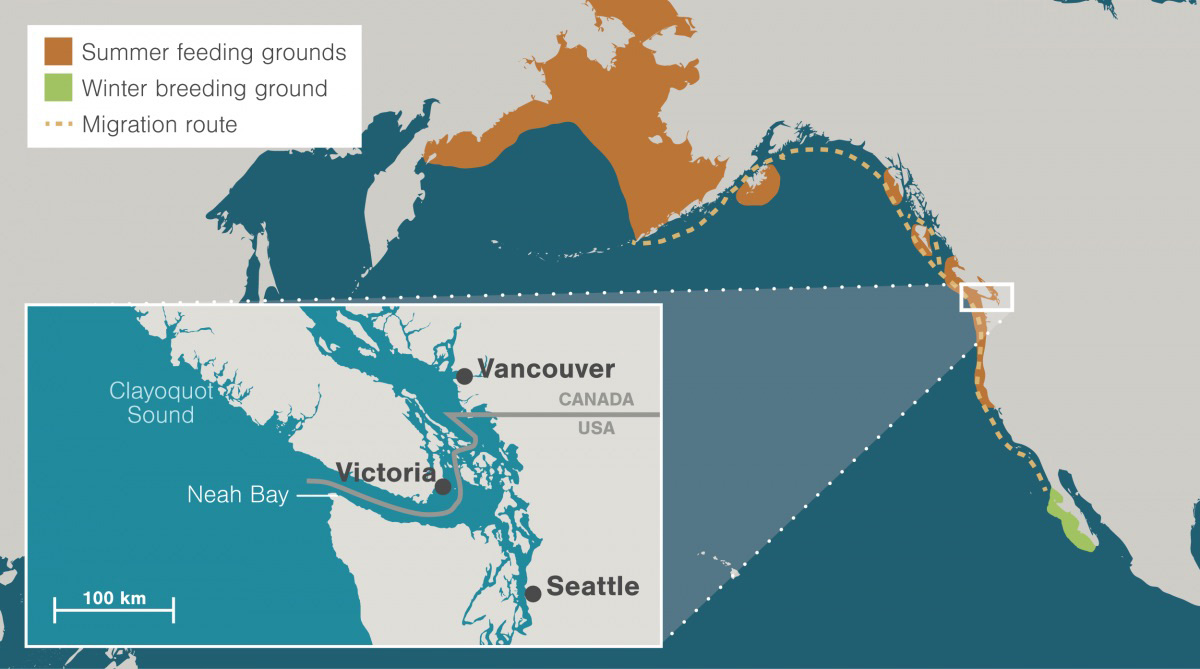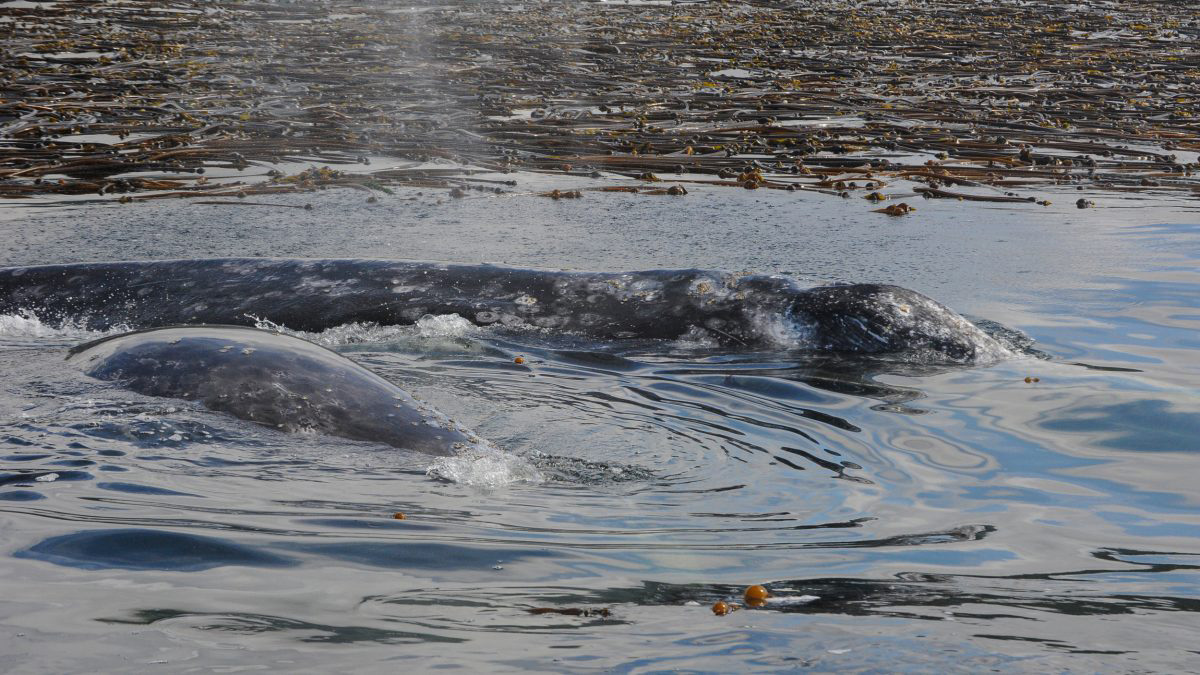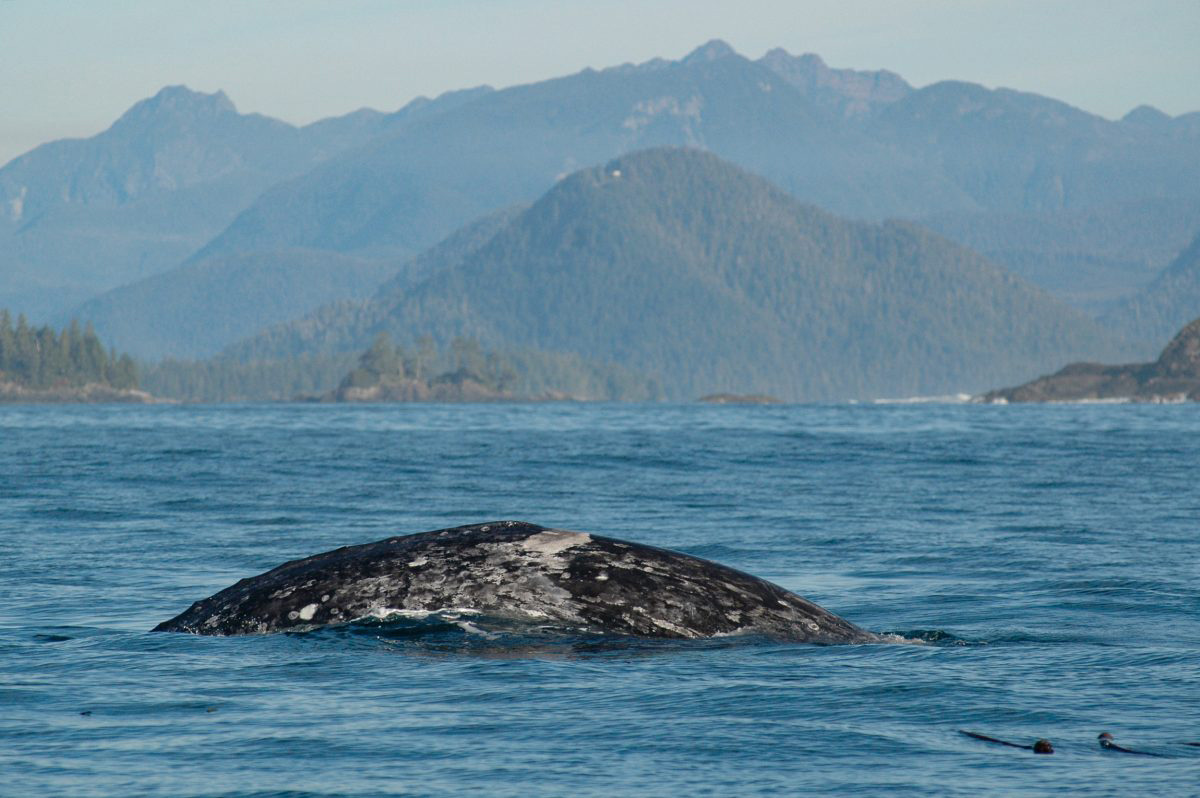For almost five decades, biologist Jim Darling has studied the grey whales that regularly return to forage in the waters off the west coast of Canada instead of completing the lengthy migration undertaken by the main herd.
Approximately 27,000 eastern North Pacific grey whales make a monumental annual trek from breeding and calving lagoons along Mexico’s Baja California peninsula to summer feeding grounds in the Bering, Beaufort and Chukchi Seas. The northward migration lasts from February until May. Then, in October, the whales, led by pregnant females, leave the Arctic feeding grounds and again travel up to 11,000 kilometres to return to the warm lagoons of Baja.
However, about 250 animals opt to skip the full migration and spend from spring until fall feeding along the coast from northern California to southeast Alaska.
Darling has watched generations of whales visit the coastal feeding grounds where they follow prey into areas such as Clayoquot Sound on the west coast of Vancouver Island. Depending on prey availability, other whales will spend extended residencies in Neah Bay or Puget Sound in Washington state, or in the waters off the California-Oregon border, among other feeding grounds.

Some animals visit for only one season, but many reappear annually, and mothers that have themselves grown up feeding along the coast bring their calves to the same locations, apparently instilling memories of the local ecosystem.
“The calves return for years, and possibly all their lives, to the location their mother brought them when they were very young and where they were weaned,” Darling says.
The calves are weaned in midsummer and then left alone, often hanging out with other calves for the rest of the summer and fall. While some are assumed to join the southward migration of the main herd as it passes Clayoquot Sound in December, others stay through the winter.
Mature females are key to the tendency to stay in coastal feeding areas because they are the ones that have the experience finding prey. That information is passed down to their offspring, says Darling, who, assisted by a photo-identification program, can identify many of the seasonally resident whales.
He recognizes Saddle, a male who was in Clayoquot Sound when Darling’s study began in the 1970s; Blackjack, a female who has visited the area for 45 years; Elvis, a female who has had three calves since 1993; and Collage, a grandmother, first recorded in 1975, whose daughter and grand-calf also sometimes return to the sound.
“This is a community of whales. They know each other, in some cases for decades. They know how to sustain themselves here — this is their home. They are not just a random aggregation of whales that don’t happen to migrate all the way north,” Darling says.
But a cross-border controversy is brewing that could put some of the whales that break off from the main migration, identified as the Pacific Coast Feeding Group, directly in the harpoon sights of the Makah Tribe, based in Neah Bay, who have applied to hunt up to 25 whales over 10 years.
The Makah is the only tribe in the U.S. with an explicit treaty right to hunt whales. They legally killed one whale in 1999 and illegally killed another in 2007.
The proposal for the renewed hunt is being supported by the U.S. National Marine Fisheries Service, a branch of the National Oceanic and Atmospheric Administration, which has asked an administrative law judge for a waiver to the Marine Mammal Protection Act — legislation that protects marine mammals in U.S. waters from lethal activities.
Hearings into the waiver application, held in late 2019, wrapped up after the NMFS, the Makah and groups opposing the hunt presented evidence. The public comment period closed March 16, and the next step is for the judge to make a recommendation on whether the hunt should go ahead.
But while the U.S. is considering whether to allow the hunt, in Canada, the Committee on the Status of Endangered Wildlife in Canada recommended to the environment minister in October 2018 that the Pacific group should be designated as endangered under the Species at Risk Act.
Fisheries and Oceans Canada will ask for feedback on listing the whales later this year. If the recommendation to classify them as endangered is accepted, the population and their critical habitats will receive additional protection, and a recovery strategy will be put into action, says DFO communications advisor Lara Sloan.
That would mean that if the Makah hunt is approved in the U.S., the very whales that are protected in Canada could be hunted just across the border.
Differences in how to treat the whales centre on data interpretation — whether the whales should be regarded as a separate stock, which would give them extra protection, or be included with the overall eastern North Pacific grey whale population. U.S. scientists view the Pacific group as an aggregation rather than a stock, so deem a separate management plan unnecessary.
A successful hunt, taking the maximum allowable whales, would reduce the eastern North Pacific grey whale population by only about 0.009 per cent a year, said Chris Yates, the NMFS’s assistant regional administrator for protected resources, in a declaration to the hearings.
However, critics say that whether the Pacific group is considered an aggregation or a unique stock, killing one whale out of 250 would have a significant effect.
“The most faithful whales to our area will be the most punished,” said Margaret Owens of the Peninsula Citizens for the Protection of Whales in a rebuttal to Yates’s declaration.
Darling and Timothy Frasier, an associate professor of biology at Saint Mary’s University in Halifax, Nova Scotia, conducted key research on the Pacific group that helped convince Canada’s endangered wildlife committee to make the endangered status recommendation. Darling and Frasier have no doubt that the Pacific group is a distinct group that acts differently from the main population and shows genetic differences, so should be managed separately.
More than a decade ago, Darling and Frasier began to investigate the genetics of these whales that seemed to show an affinity for the west coast of Vancouver Island. The pair published two research papers, in 2011 and 2013, which found that the whales using the coastal feeding areas possessed a unique genetic signature in their mitochondrial DNA.
Mitochondrial DNA is inherited from the mother and nuclear DNA is inherited from both parents. Although the Pacific group whales are known to mix and mate with the main population, as is evident in their nuclear DNA, their preference for returning to coastal feeding areas is a behaviour that shows up in their mitochondrial DNA signature, Frasier explains.
The mitochondrial DNA in the Pacific group “represent whales who learned about this feeding area, instead of the Arctic, from their mothers and then passed that along to their offspring generation after generation,” Frasier says. “[It] reflects the maternally-based knowledge transfer of migratory routes and feeding ground locations.”
The NMFS, however, has chosen to base its decision on mitochondrial and nuclear DNA from all whales using these coastal feeding areas — including those that stay for only one season — instead of looking exclusively at whales that regularly return.
“If you lump them all together and take all the whales that have ever been seen in the Pacific area and compare them to the rest of the population, that [mitochondrial DNA] signal gets diluted because you’re including a lot of individuals that don’t really qualify,” Frasier says. “Then, of course, you are going to come to different conclusions.”
After Darling and Frasier completed their initial research, it was presented at a 2010 International Whaling Commission meeting. The NMFS then did its own study, which yielded similar results. The matter of how to treat the Pacific group seemed to be settled — to the point that it brought a 2012 NMFS assessment of the impact of a Makah hunt to a halt.

Darling is baffled that, after accepting the research a few years ago, the marine fisheries service is now questioning the extent of the genetic and behavioural differences. “I really do not understand it... it is so inexplicable if you are just looking at the biology,” he says.
Current NMFS views are based on a report from a 2012 task force and agency-only workshop, convened to review North Pacific grey whale data. Workshop participants looked at all whales using the coastal feeding areas, including those temporarily recruited from outside the Pacific group, and concluded there was insufficient evidence to classify the group as a separate stock, and that research should continue.
Donna Wieting, director of NOAA’s Office of Protected Resources, cites the report in a 2018 letter to the Pacific Scientific Review Group (which advises NOAA on the status of marine mammals) saying, “there remains a substantial level of uncertainty in the strength of the lines of evidence supporting demographic independence of the Pacific group.”
That view was echoed at the 2019 hearings on the renewed Makah hunt by NMFS wildlife research biologist David Weller.
He noted in a submission that when samples from the Pacific whales were compared with whales sampled in one of the Mexican wintering lagoons, the 2012 task force found “small but significant” differences in mitochondrial DNA (inherited from the mother), but no significant differences in analyses of the nuclear DNA (inherited from both parents).
“Calves likely follow their mothers to feeding areas and to some extent they return to those feeding areas in subsequent years. There was no evidence, however, that whales that frequent one feeding area are reproductively isolated from whales that frequent other feeding areas,” Weller wrote in his declaration.
Other scientists are questioning how the decision was made and want to see a wider-ranging discussion.
Research biologist John Calambokidis, founder of Cascadia Research Collective based in Olympia, Washington, has conducted extensive research on eastern North Pacific grey whales.
“For management purposes, I absolutely do think [the Pacific group] warrants treatment as a distinct group, based on both the photo ID information and the genetic data that has come out of two different studies,” he says.
Calambokidis questions the task force–workshop method of deciding the status of the Pacific group and the conclusion that, as there was insufficient evidence, further research was required.
“I think NMFS should reconsider their status on the Pacific group, especially because the workshop was inconclusive and there is now more information,” he says. He’d also like to see the decision revisited by a wider group of scientists.
D.J. Schubert, a wildlife biologist with the Animal Welfare Institute, a non-profit organization in Washington, D.C. that is presenting at the hearings, believes the separate stock argument is compelling, and he also wants to see NMFS call another meeting of scientists to look at the evidence.
“But they shouldn’t limit it to just their scientists; they need to invite outside scientists who do most of the research on these whales,” he says.
Oddly, although NMFS does not consider the Pacific group whales a separate stock, in an apparent concession to documented differences, it has proposed restrictions to protect the group and a small population of western North Pacific grey whales if the hunt goes ahead. (Some of the western population, a group once considered extinct, were recently tagged and found in areas used by eastern North Pacific grey whales).
Over a 10-year time frame, for instance, no more than 16 hunting strikes could be on Pacific group whales, with a limit of eight strikes on females, and the hunt would be stopped if the number of Pacific group whales falls below 192 animals.
In even-numbered years, the hunt would take place during the migration season, reducing the risk to Pacific group whales, as the entire herd of 27,000 animals would be passing through the area. In odd-numbered years, the hunt would be held during the summer feeding season to reduce the risk to western North Pacific whales. But, inevitably, that timing would increase the risk of striking any Pacific group whales feeding in the area.
“To say they will hunt in the summer is absurd. That means the only whales that are present are the small population of local animals, which [the Canadian endangered wildlife committee] says are endangered,” Darling says.
If the hunt is approved, in the heat of the moment it will be largely impossible to differentiate between a Pacific group whale and the rest of the herd before shooting, says Frasier.
“A theoretical option is to have someone who knows the whales out there and say, ‘That’s not one of our residents,’ but, to me, that’s not really workable,” he says.
So far, DFO has not been part of the debate on the status of the Pacific group, but that is likely to change if the government approves the Species at Risk designation after public consultations that could be held this fall.
“If the recommendations are accepted, then DFO will automatically receive the mandate to provide science advice on these units, including the designation of critical habitat,” says Thomas Doniol-Valcroze, head of DFO’s cetacean research program.
Adding to the uncertainty over the status and classification of the whales is that the entire eastern North Pacific grey whale population is undergoing an unusual mortality event, or UME, with 326 grey whales found dead along the coast from Mexico to Alaska in 2019 and up to May 12, 2020. Scientists estimate that the carcasses found probably represent only between 3.9 and 13 per cent of the whales that have died.
Although the current UME is not over, NMFS points to the population’s recovery after a 1999–2000 UME that killed up to one-quarter of the eastern North Pacific grey whales as evidence of their resilience. This is despite the fact that the cause of the previous UME was undetermined.
The cause of the current UME is similarly unclear. Although some whales have shown evidence of emaciation, findings are not consistent, according to NOAA, which is assembling a team of scientists to review data and determine the next step.
Climate change, a lack of adequate food in the Arctic, and a theory that the grey whale population has reached carrying capacity — the maximum number of animals for its habitat — are among the considerations. Recent research suggests ship strikes and predation by killer whales may also be to blame.
*
While the scientists wrangle over the outstanding questions of how to classify and manage the grey whales, and how and whether to insert the current UME into the equation, other groups question the revived Makah hunt — a right granted the nation in 1855 — on the grounds of animal rights or other more philosophical concerns.
For Darling, though, the focus should remain on science, not politics. This is not about whether whaling should occur, he says, it’s about getting the biology correct so the impacts and consequences of a hunt and other activities that affect the population are clearly understood.
NMFS is currently preparing a supplemental environmental impact statement. If the recommendation from the judge is for the hunt to proceed, the decision will then go to the NMFS assistant administrator, followed by a 20-day public comment period.
If the hunt is given the go-ahead by the assistant administrator, regulations will be finalized and discussions held with the Makah on the particulars of the hunt.
Whichever way the decision goes, the battle is unlikely to be over, as litigation will probably follow, says Schubert.
The grey whales are currently on their northward migration, and as they make their way up the west coast of North America, they face the uncertainties of a changing ocean. Scientists are also watching to see whether the number of mystery deaths will increase.
This year, the whales will not have to contend with Makah harpoons and rifles off Neah Bay, but there is no guarantee that the hunt won’t become another hazard they face during future migrations. ![]()
Read more: Environment
















Tyee Commenting Guidelines
Comments that violate guidelines risk being deleted, and violations may result in a temporary or permanent user ban. Maintain the spirit of good conversation to stay in the discussion.
*Please note The Tyee is not a forum for spreading misinformation about COVID-19, denying its existence or minimizing its risk to public health.
Do:
Do not: